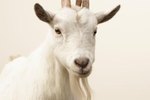Things You'll Need
Legume hay
Grain mixture
Deworming product
Warnings
Don’t feed your goats grain mixes formulated for sheep. Such grain mixes don’t contain enough copper for goats.
Tips
Choose a goat native to the area where you’re living. Native goats will be more resistant to native parasites and diseases, which means they may produce more milk. Feed goats in separate stalls to make sure they each get their share of food.
Female goats are known as "does" or "nannies." Good milk production in nanny goats is dependent on the food she receives while producing milk, the care she receives during her dry period, how clean her living quarters are and whether or not she’s infected with parasites or not. The two most important factors are the quality of the hay and the grain mix.
Feed
Feed your nanny goat quality hay from legumes. Good hay provides 15-to-20 percent protein. Alfalfa is the best legume hay, because it contains more protein than other hays. Other good legumes include alyce clover and perennial peanut.
Feed your goat 2-to-3 lb. of grain every day. Some farmers allow 1/2 pound of grain for every 1 qt. of milk the doe produces. The contents of the mix can vary, but may contain corn, oats and soybean meal, with added vitamins and minerals. It should provide 14-to-20 percent protein.
Include fiber in your goat’s diet. Good fiber encourages goats to chew, and stimulates rumination. When goats don’t chew enough, the content of their milk fat decreases. Good sources of fiber for milk goats are sunflower and cotton seeds.
Parasites
Deworm your nanny goats a few days before putting them in the pasture in the spring. Deworm them again several weeks later. Another good time to deworm goats is after a hard frost in the fall. Identify parasites with a fecal examination, performed by the vet, and treat with a product appropriate for that parasite.
Control worms and other parasites by moving your nanny goats around between pastures. Don’t allow them to graze too close to the ground, because there are more parasites close to the ground. Crops should be grazed from 2-to-10 inches, depending on the crop. Your county extension agent will have information about specific crops.
Keep your nanny goat’s stall clean. Don’t allow her to stand in feces.
Dry Period
Provide your nanny goat with a “dry period” every year. The dry period should coincide with the period when she is bred, and should last about two months. High milk producers need a longer dry period in order to replenish nutrients lost during milk production. When your doe starts producing milk again, she might only produce 65- to-75 percent as much milk as before.
Reduce or totally eliminate grain consumption during the dry period. Substitute quality grass-hay for her legume hay. Provide her with a mineral mixture that includes calcium, phosphorus and salt, with other trace minerals and vitamins.
Resume feeding your doe quality hay during the last month of her gestation.
References
- Living the Country Life: Raising Dairy Goats For Your Family’s Milk Supply
- Penn State Cooperative Extension: Goat Parasites
- Goat Connection: Feeding Goats for Improved Milk and Meat Production
- National Sustainable Agriculture Information Service: Dairy Goats – Sustainable Production
- Agricultural Alternatives: Dairy Goat Production, p. 3
Tips
- Choose a goat native to the area where you're living. Native goats will be more resistant to native parasites and diseases, which means they may produce more milk. Feed goats in separate stalls to make sure they each get their share of food.
Warnings
- Don't feed your goats grain mixes formulated for sheep. Such grain mixes don't contain enough copper for goats.
Photo Credits
-
goat on the farm image by Ivonne Wierink from Fotolia.com
Writer Bio
Lani Thompson began writing in 1987 as a journalist for the "Pequawket Valley News." In 1993 she became managing editor of the "Independent Observer" in East Stoneham, Maine. Thompson also developed and produced the "Clan Thompson Celiac Pocketguides" for people with celiac disease. She attended the University of New Hampshire.





